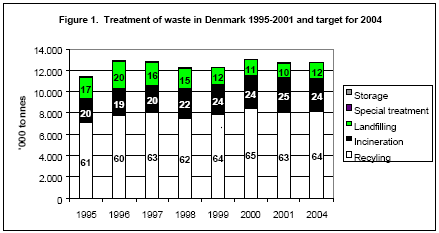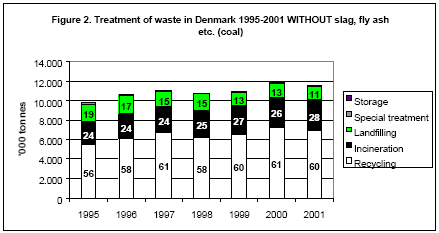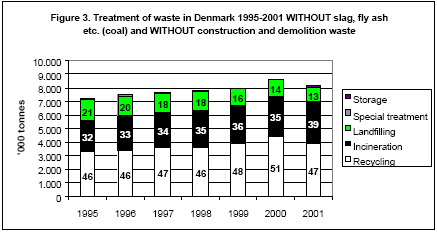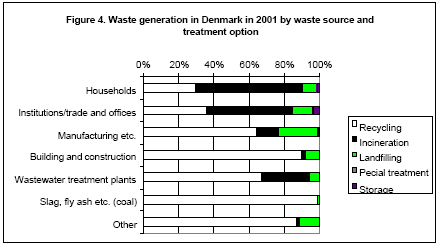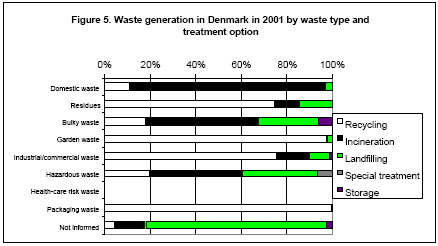|
Waste Statistics 2001 2 Waste generation and treatment2.1 Waste generation 2001 and developments 2000 – 2001Waste generation in 2001 and developments in waste arisings from 2000 to 2001 are presented in Table 1. In 2001, Danish waste generation amounted to 12,768,000 tonnes. This corresponds to a decrease of 2 per cent compared to waste generation in 2000. Reductions are primarily due to the fact that sludge for mineralisation in 2001 is stated with a dry matter content of 20 per cent, which is new compared to previous statistics. In previous years dry matter content for sludge for mineralisation has been 1.5 per cent. Sludge for mineralisation has been adjusted to a dry matter content of 20 per cent. Thus mineralised sludge amounts are incorporated into the statistics with the same dry matter content as the remaining sludge. This means that sludge amounts have been reduced by 808,886 tonnes. Part of the reduction stems from a fall in waste arisings from industry, [1] an 11 per cent reduction compared to 2000. This reduction is to a large extent due to a decrease of 223,000 tonnes in ferrous scrap.
Source: the ISAG, Danisco, Association of Danish Recycling Industries and other large scrap dealers, Elsam, Energi E2, and reports to the Danish EPA on sludge from municipal plants applied to farmland etc. and incineration of sludge at sludge incineration plants. (The figures for sludge for recycling and incineration are 2000 figures). Sludge amounts are stated in wet weight, excluding however sludge for mineralisation which has been adjusted to 20 per cent dry matter. Sludge for long-term storage has been included in sludge amounts applied to farmland etc. Sludge for recovery has been included in sludge amounts for incineration. The figures do not include imports of waste. Waste generation is stated as the amounts of waste delivered to treatment plants from all primary sources. Primary sources include waste generation from sources other than waste treatment plants (reprocessing plants, incineration plants, composting/biogas plants and landfills). Slag, fly ash and flue-gas cleaning products from waste incinerations plants have therefore not been included in the calculations, since this would mean a double registration of the waste. Waste generation from the primary source "recycling centres/transfer stations" has been allocated to other primary sources. The principles behind this allocation are explained in Annex 2. Waste from households amounted to 3,083,000 tonnes in 2001. This means that 2001 waste generation was virtually the same as in 2000. Domestic waste arisings remain almost unchanged from the previous year; except from a slight increase of 25,000 tonnes. As Table 1 shows, domestic waste arisings have remained almost unchanged throughout the period 1995 – 2000 – showing only very slight changes from year to year [2]. There is a fall in the three remaining subcategories under household waste. The amounts of bulky waste and garden waste have fallen by respectively 7 per cent, or 50,000 tonnes, and 12 per cent, or 61,000 tonnes, compared to 2000. Waste registered as "other" has fallen by 14 per cent - a total amount of 22,000 tonnes. Amounts of separated packaging waste were reported to the ISAG for the first time in 2001. The total amount of packaging waste reported to the ISAG is 142,898 tonnes. Of this amount, 107,000 tonnes have been registered as domestic waste generated by households in 2001. The generation of waste in the service sector [3]amounted to 1,307,000 tonnes in 2001, which is a 17 per cent increase compared to the 2000 amount – in absolute figures an increase of 188,000 tonnes. The increase is apparent in all fractions except bottles and glass, but it should be noted that the fractions "waste not suitable for incineration", "paper and cardboard", "food waste/other organic waste", "health-care risk waste" and "hazardous waste" increased by 54 per cent, 8 per cent, 25 per cent, 40 per cent, and 29 per cent respectively compared to 2000. Glass is the only fraction showing a fall. The decrease is equivalent to 38 per cent less glass being separated by the service sector. The fall can be explained partly by the changes in the registration of bottles and glass from recycling centres/transfer stations, meaning that around 37,500 tonnes of glass have been moved from the service sector to households. The amounts of waste from industry [4]have fallen. For this source of waste, amounts have fallen from 2,948,000 tonnes in 2000 to 2,616,000 tonnes in 2001 - a decrease of 332,000 tonnes or 11 per cent. The year before, industry experienced an 11 per cent increase in waste arisings. The fall is primarily due to reductions in the fractions "waste suitable for incineration", "waste not suitable for incineration", "paper and cardboard", "food waste/other organic waste", and "ferrous metals". These fractions were reduced by 29 per cent, 35 per cent, 7 per cent, 33 per cent, and 19 per cent respectively. By contrast, the fractions "beet soil", "sludge", "hazardous waste", and "other" have shown an increase of 16 per cent, 24 per cent, 90 per cent, and 38 per cent respectively. The 90 per cent increase in hazardous waste is due to shredder waste having been included in the statistics as a hazardous waste fraction for the first time. Shredder waste was previously registered as part of the non-hazardous fraction "various unburnable". The generation of waste in the building and construction sector was larger in 2001 than in 2000 – construction and demolition waste arisings reached 3,391,000 tonnes, which corresponds to 168,000 tonnes or 5 per cent more than in 2000. By far the major part, or 90 per cent, of waste generated by the building and construction sector is recycled. There has been a 24 per cent reduction in amounts of sludge from municipal wastewater treatment plants. In 2001 that figure was 1,123,000 [5] tonnes, calculated at a dry matter content of 20 per cent. This is 363,000 tonnes less than in 2000. The decrease is due to the new method of calculation mentioned above, used when calculating sludge for mineralisation. Waste generation at coal-fired power plants increased by 3 per cent - a rise from 1,176,000 tonnes in 2000 to 1,211,000 tonnes in 2001. This is due to the fact that energy generation was larger in 2001 than in 2000. Denmark had net exports of electricity in 2001. During the period 1995-2001, waste arisings from coal-fired power plants fell. For the first time in this period, Denmark had net imports of electricity in 2000. Another significant reason for the decrease in residues from coal-fired power plants is that energy to a still larger extent is generated from other fuels than coal and coke [6]. 2.2 Treatment of waste in 2001In the following, developments in treatment of total waste arisings are presented. Furthermore, treatment is related to targets for treatment in the Danish Government's Waste Management Plan 1998 – 2004, Waste 21. Table 2 shows that 8,101,000 tonnes, corresponding to 63 per cent of total waste arisings, were recycled in 2001. In actual figures this means a 360,000-tonne reduction, corresponding to 4 per cent in comparison to 2000.
Source: Same as Table 1, plus the Danish Government's Waste Management Plan 1998 – 2004, Waste 21. The total sum of the percentage distribution on the different treatment options for 2001 does not add up to 100 per cent due to rounding. "Special treatment" includes treatment of hazardous waste, also health-care risk waste. Waste incinerated in 2001 amounted to 3,221,000 tonnes. This is actually an increase in amounts of 135,000 tonnes, which as a share of total waste arisings is 25 per cent, as compared to 24 per cent the previous year. Waste led to landfill in 2001 amounted to 1,317,000 tonnes, which is a decrease of 172,000 tonnes from 2000. The rate of landfilled waste amounts to 10 per cent of total arisings. The percentage share of waste led to landfill has fallen by 5 percentage points in the period 1998 to 2001 corresponding to a reduction in landfilled waste arisings of 551,000 tonnes. As the table shows, the relative distribution in recent years among treatment options has varied only little. Variations are often explained by developments in amounts of the different fractions. For example, variations in amounts of residues from coal-fired power plants and construction and demolition waste have large implications on the total rate of recycling, as these two waste types account for a large percentage of total waste arisings and typically have a rate of recycling of 90 per cent or more. According to Waste 21, short-term targets for stabilisation of waste generation are supplemented by a number of qualitative elements such as better exploitation of resources in waste, better quality in treatment of waste and mitigation of problems caused by environmental contaminants in waste. Overall, targets for sectors and fractions mean that the rate of recycling will increase, that more waste is incinerated, and that the need for landfilling will decrease. Overall targets in Waste 21 for waste management in year 2004 are 64 per cent recycling, 24 per cent incineration and a maximum of 12 per cent landfilling. As Figure 1 shows, overall targets for waste treatment were already reached in 1999. The year 2001 has shown a diversion among treatment options primarily due to the new method of calculation for sludge. This means that the rate of waste for recycling has fallen 2 per cent compared to 2000 and is now one percentage point from the target for year 2004. Correspondingly, the target for landfilled waste has been surpassed. This is believed to be attributable to the ban on landfilling of waste suitable for incineration that came into effect on 1 January 1997. However, other factors play a role.
Source: Same as Table 1. Note that total waste arisings in 2004 have been set to correspond to waste arisings in 2001. The figure is not intended as a projection of developments in total waste arisings for 2004. First of all, amounts of residues from coal-fired power plants have decreased significantly. Furthermore, they are recycled to a larger extent than in previous years when they were mainly landfilled. 2.3 Treatment of waste, WITHOUT residues and construction and demolition wasteAmounts of residues from coal-fired power plants not only depend on energy consumption in Denmark, but also on exports of electricity to Sweden and Norway. In addition, due to Energy 21 a still larger shift is taking place from use of coal and coke as fuel to use of natural gas and renewable energy. Since 1996, when Danish electricity exports to Sweden and Norway were particularly large, amounts of residues have decreased steadily. In actual figures this means a decrease of 1,120,600 tonnes, corresponding almost to an almost 50 per cent reduction. Naturally, this has an impact on developments of total waste arisings, but as residues have a very high rate of recycling, it also has an impact on compliance with overall treatment targets. A similar picture is seen for construction and demolition waste. As discussed in section 6.2, the rate of recycling of construction and demolition waste typically reaches around 90 per cent. Therefore, it is interesting to look at the distribution of waste between the different treatment options when residues and construction and demolition waste are kept apart from statistics. Figure 2 shows the distribution of the different treatment options when residues from coal-fired power plants are kept apart from statistics.
Source: Same as Table 1. When residues are kept apart it is seen that 60 per cent of the remaining waste was recycled in 2001, which is a decrease of 386,000 tonnes from 2000. The rate of remaining waste incinerated in 2001 was 28 per cent, which is to say that 157,000 tonnes more waste were incinerated in 2001 than in the year before. The rate of waste for landfilling is 11 per cent, which is a 182,000-tonne reduction compared to 2000. In absolute figures this means that in 2001, apart from residues, 11,556,000 tonnes of waste were generated. Of these, 6,899,000 tonnes were recycled, 3,221,000 tonnes were incinerated, and 1,307,000 tonnes were landfilled. Special treatment was given to 20,000 tonnes, and 109,000 tonnes were temporarily landfilled until incineration capacity becomes available [7]. Total waste amounts without waste from coal-fired power plants increased by 18 per cent from 1995 to 2001. In Figure 3 waste from the building and construction sector has also been kept apart from statistics. This causes a decrease in the rate of remaining waste for recycling, whereas the rates for incineration and landfilling increase. Residues from coal-fired power plants and construction and demolition waste are recycled to a very large extent: in 2001, 99 per cent and 90 per cent respectively, cf. Chapter 6. It is seen that these two fractions play a very significant role in the meeting of overall waste treatment targets in Waste 21.
Source: Same as Table 1. 2.4 Treatment by sources and waste typesFigure 4 shows total waste generation in 2001 distributed on sources and treatment options. Figure 5 shows waste generation distributed on waste types and treatment options. Tables with detailed figures are given in Annex 1. Figure 4 shows that especially waste from the building and construction sector, coal-fired power plants and wastewater treatment plants are characterised by a very high rate of recycling. Waste 21 targets for recycling have been met for waste from these three sectors. The rate of recycling of waste from industry is also relatively high: 65 per cent, which means the target for recycling is met. The high rate of recycling, however, is especially attributable to recycling of ferrous metals. Still too much waste from this sector is led to landfill - 22 per cent against the target of only 15 per cent, and there is a challenge ahead to divert larger amounts of the other fractions from landfilling to incineration or recycling. The rate of recycling of waste from the service sector is not sufficient compared to the target in Waste 21. In 2001, 36 per cent of waste was recycled compared to the target of 50 per cent. The target of 45 per cent incineration has been reached, but also in this sector too much waste is led to landfill; 12 per cent compared to the target of 5 per cent. The challenge here is to divert more waste from landfilling to recycling.
Source: Same as Table 1. Treatment of the waste type domestic waste does not comply with the targets in Waste 21, cf. Figure 5. Only 16 per cent of this waste was recycled in 2001. The recycling rate for the period 1995-2001 has oscillated between 15 per cent and 17 per cent. The target is to reach a recycling rate of 30 per cent in 2004, whereas the targets for incineration and landfilling are 70 per cent and per cent respectively. The rate of domestic waste incinerated in 2001 reached 82 per cent, whereas 3 per cent was led to landfill [8].
Source: Same as Table 1. 2.5 Developments in waste generation 1995 - 2001Table 3 shows total waste arisings in Denmark for the years 1995 - 2001. Waste generation analysed by commercial sources. There is an 11 per cent increase in total waste arisings in the period 1995-2001. Waste generation was largest in 2000. The reduction in 2001 in waste arisings should be seen in the context of the changes in the methods of calculation used. There was an increase of 13 per cent in amounts of waste from 1995 to 1996, after which amounts decreased by approximately 5 per cent up to 1999. From 1999 to 2000 waste arisings have increased by 7 per cent. From 2000 to 2001 waste arisings have fallen 2 per cent. The increase in the first half of the 1990s may partly be due to the fact that coverage of the ISAG system has increased and partly due to real increases in waste amounts. The large amounts in 1996 were primarily due to particularly high amounts of residues from coal-fired power plants in 1996 – which again was due to large exports of electricity to Sweden and Norway.
Source: Same as Table 1. Footnotes[1]Manufacturing industries etc. [2]Developments from 1995 to 2001 are described in more detail in section 2.5. [3]Institutions/trade and offices. [4]Manufacturing industries. [5] The 2001 figures from municipal wastewater treatment plants of amounts of sludge applied to farmland and incineration of sludge at sludge incineration plants is not yet available. For recycling and incineration, 2000 figures from the Danish Environmental Protection Agency's sludge statistics have been used, whereas for landfilling the ISAG figures for year 2001 have been used. [6] The Danish Energy Agency's preliminary statement of energy generation, consumption and CO2 emissions. [7] Exemption clause in Section 37(3) Danish Statutory Order on Waste (Statutory Order No. 619 of 27 June 2000). [8] Note that organic domestic waste is to be be assigned to incineration. However, for islands that do not have a land connection to the mainland there is an exemption from this obligation.
|
|||||||||||||||||||||||||||||||||||||||||||||||||||||||||||||||||||||||||||||||||||||||||||||||||||||||||||||||||||||||||||||||||||||||||||||||||||||||||||||||||||||||||||||||||||||||||||||||||||||||||||||||||||||||||||||||||||||||||||||||||||||||||||||||||||||||||||||||||||||||||||||||||||||||||||||||||||||||||||||||||||||||||||||||||||||||||||||
